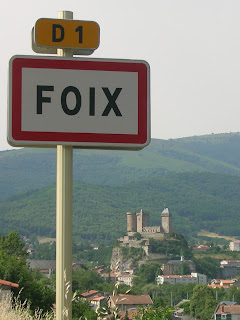
Food shows up everywhere in France. Last week I picked up a crafts magazine, its pages filled with dauntingly ambitious projects, its front cover sporting a small book of recipes for jams and chutneys.
Chutney de courgettes (zucchini) sounded intriguing so, Monday, I assembled all the ingredients at Mirepoix market and at SuperU (the local supermarket which had courgettes on special: two kilos for 1.95 euros). I couldn't find a bird's eye chili so I bought a Spanish one instead, as scarlet and glossy as a tart's patent leather shoes.
The only mistake I made, I think, was the vinaigre blanc. Bottom shelf stuff, it came in the same kind of plastic bottle that you find turpentine and bleach in and, when I unscrewed the cap, it gave off such an eye-watering whiff that I used white wine vinegar instead. The recipe filled five Bonne Maman jam jars (which tells you something about our confiture consumption) with a bit left over.
At about 10 a.m. yesterday morning, I heard the toot-toot of the butcher's truck announcing that it had arrived at the end of Impasse de l'église. Some of the village's older residents were already there when I arrived, buying little packages of this and that from the young woman behind the counter.
I asked her if she had any of the meat mixture used for stuffing vegetables at this time of year. Peppers, aubergines, courgettes, tomatoes... Yes, she said, pointing to a fat coil of homemade sausages. I bought a length, and she carefully sliced it open and packaged the contents to make my life easier. Speaking of making life easier: right now, she also sells sausage-stuffed quail wrapped in bacon, all ready to go in the oven.
Later, the same day. Plans easily go awry here. Having a big glass of red with friends in their garden meant it was 7:30 p.m. before we walked in the door. Possibly later Anyway, too late to start faffing around with stuffing courgettes.
A staple in our pantry is a big tin of duck confit. Peter opened it (the peculiarities of French can openers are a whole other separate post, as is their curious take on plastic wrap) and two legs went into the frypan to warm through and crisp.
Meanwhile, I boiled some potatoes. Most of the duck fat that melted off the confit went into a small jar, to be stored in the fridge. That way, the duck skin could get golden and crunchy. Around the duck, I arranged cooked potato wedges so they could do the same. The new chutney de courgettes was very good with it all in a sweet/duck à l'orange sort of way, and a green salad added a bit of desirable edge to all that richness.

 nerve to go inside knowing that I would leave in a chocolate-induced coma.
nerve to go inside knowing that I would leave in a chocolate-induced coma. 




























